
Groundbreaking Fossil Discovery Unveils Secrets of New Zealand’s Extinct Dolphin-Reptiles
2024-12-30
Author: Rajesh
A fascinating new chapter in paleontology has emerged with the discovery of a rare fossil, offering unprecedented insights into New Zealand's extinct ichthyosaurs—reptiles that roamed the seas during the age of dinosaurs. Evolving around 250 million years ago, these creatures resembled modern dolphins and fish, yet mysteriously went extinct approximately 94 million years ago.
The fossil was unearthed in 2010 by esteemed palaeontologist James Crampton while he was conducting research at Coverham Station in the Clarence Valley, North Canterbury. Dating back to the Late Cretaceous epoch, this ichthyosaur skeleton is estimated to be nearly 100 million years old, specifically from the Cenomanian stage. Initially discovered encased in a tough concretion, the fossil remained securely stored at GNS Science until 2021, when its significance was fully recognized thanks to its distinctive hourglass-shaped vertebrae.
This newly analyzed specimen stands out as the most complete ichthyosaur fossil discovered to date in New Zealand, providing vital information that greatly enhances our understanding of these marine reptiles in the region. Prior to this, the only known ichthyosaur remnants from the Cretaceous period in New Zealand were limited to a few fragmented bones from different individuals, all found in the North Island.
Technological Marvel: 3D Imaging Uncovers New Insights
To delve deeper into the anatomical details of this remarkable fossil, expert fossil preparator Al Mannering employed a medical CT scanner, allowing researchers to visualize bones hidden within the hardened rock—a process known as virtual preparation. This resulted in detailed 3D renderings, showcasing critical elements such as a partial skull base, shoulder regions, a complete left pelvis, and much of a hind flipper, among various vertebrae and other bones.
Notably, this specimen represents one of the youngest ichthyosaurs ever discovered, providing a tantalizing glimpse into the lives of these ancient reptiles just a few million years before their final extinction. Its well-preserved pelvis is particularly striking as bones of this type are rarely found in Cretaceous ichthyosaurs, enhancing our understanding of their anatomical diversity and evolutionary history.
Unexpected Links and Regionalism Among Marine Reptiles
Though the specimen is too fragmentary for formal classification, its unique features, including a simplified skull base and a distinct pelvic bone, provide pivotal clues to ichthyosaur evolution. Initial findings suggest this fossil belongs to the family Platypterygiidae, closely related to the Australian species Platypterygius australis and several other European ichthyosaurs. Curiously, this specimen appears to have no direct ties to ichthyosaurs from Western Gondwana, modern-day South America, despite geographic proximity during the Cretaceous period, which raises intriguing questions about regional diversity among extant species.
This contrasts sharply with younger fossils of marine reptiles such as plesiosaurs and mosasaurs, which display clear evolutionary connections across the southern continents, indicating that such links may have developed after ichthyosaurs disappeared.
In essence, this groundbreaking discovery not only enriches our knowledge of ichthyosaur diversity in the southern hemisphere but also highlights a previously unrecognized complexity in the distribution of marine reptiles around the ancient supercontinent of Gondwana. As researchers continue to explore the implications of this find, we are left wondering what other secrets lie beneath the Earth’s surface, waiting to reshape our understanding of prehistoric life.


 Brasil (PT)
Brasil (PT)
 Canada (EN)
Canada (EN)
 Chile (ES)
Chile (ES)
 Česko (CS)
Česko (CS)
 대한민국 (KO)
대한민국 (KO)
 España (ES)
España (ES)
 France (FR)
France (FR)
 Hong Kong (EN)
Hong Kong (EN)
 Italia (IT)
Italia (IT)
 日本 (JA)
日本 (JA)
 Magyarország (HU)
Magyarország (HU)
 Norge (NO)
Norge (NO)
 Polska (PL)
Polska (PL)
 Schweiz (DE)
Schweiz (DE)
 Singapore (EN)
Singapore (EN)
 Sverige (SV)
Sverige (SV)
 Suomi (FI)
Suomi (FI)
 Türkiye (TR)
Türkiye (TR)
 الإمارات العربية المتحدة (AR)
الإمارات العربية المتحدة (AR)